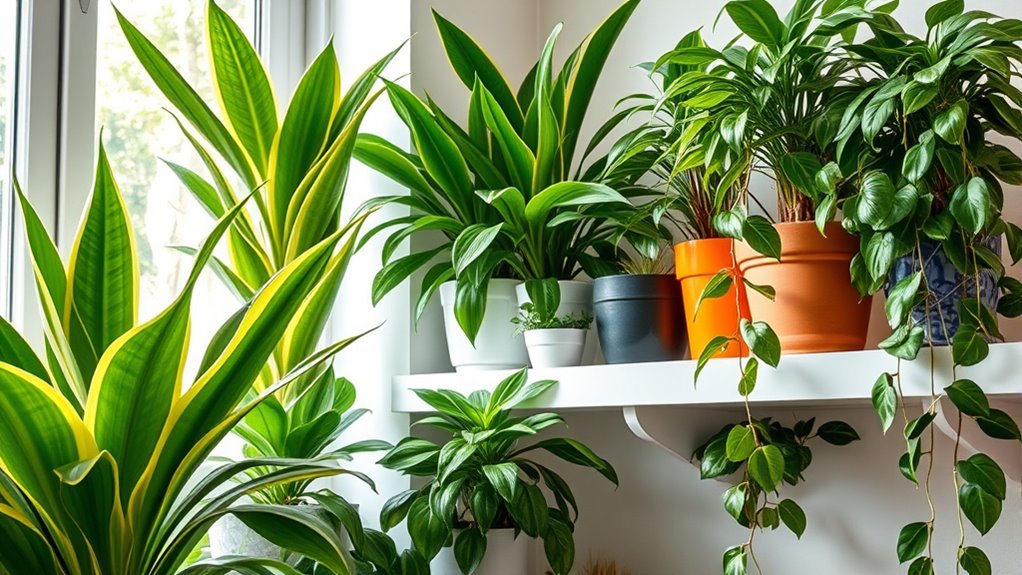If you want houseplants that quickly purify indoor air, consider snake plants, peace lilies, and rubber plants. These plants effectively filter out toxins like formaldehyde and xylene while adding beauty to your space. Other options like the Areca palm, Boston fern, and Chinese evergreen also boost air quality and thrive indoors. Keep caring for them properly, and you’ll enjoy cleaner, fresher air—more tips await if you keep exploring.
Key Takeaways
- Snake Plant effectively filters formaldehyde, xylene, and toluene, providing quick air purification with minimal maintenance.
- Areca Palm rapidly improves indoor air quality by removing common toxins and adding aesthetic tropical appeal.
- Peace Lily actively filters airborne pollutants while blooming, enhancing air quality and indoor decor simultaneously.
- Chinese Evergreen quickly enhances indoor air by absorbing chemicals, especially in low-light environments.
- Rubber Plant efficiently removes formaldehyde and traps dust, offering fast improvements to indoor air purity.
Snake Plant (Sansevieria Trifasciata)
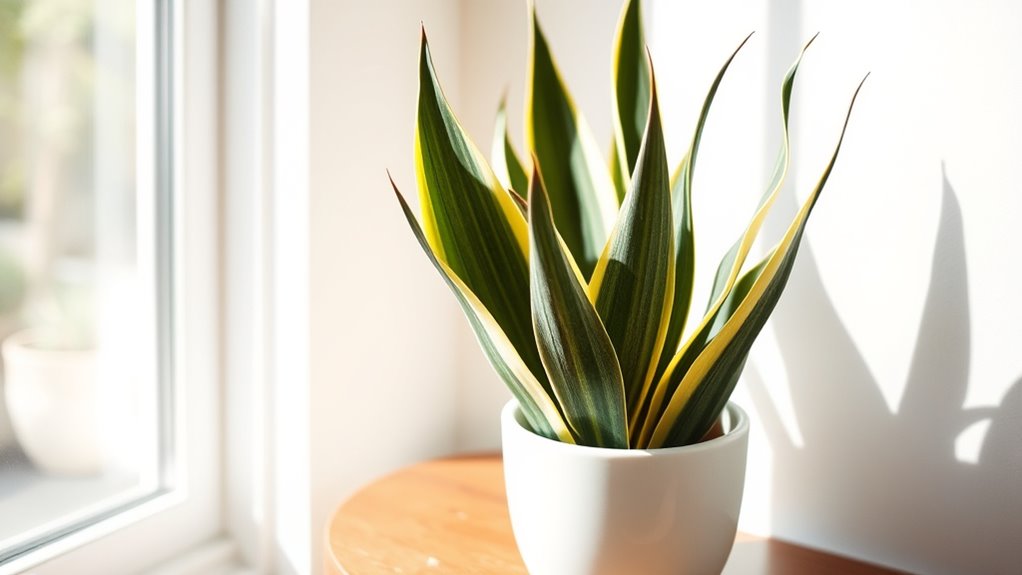
The snake plant (Sansevieria trifasciata) is a popular choice for improving indoor air quality because it actively filters toxins like formaldehyde, xylene, and toluene. When it comes to growing conditions, you want to place it in bright, indirect sunlight, but it can tolerate low light as well. It prefers well-draining soil and minimal watering—about once every few weeks—making it low-maintenance. For pest management, keep an eye out for spider mites and mealybugs, which can sometimes attack the plant. Regularly inspect the leaves, and if pests are found, treat them with insecticidal soap or neem oil. By providing suitable growing conditions and managing pests promptly, you guarantee your snake plant remains healthy and effective at purifying your indoor air.
Areca Palm (Dypsis Lutescens)
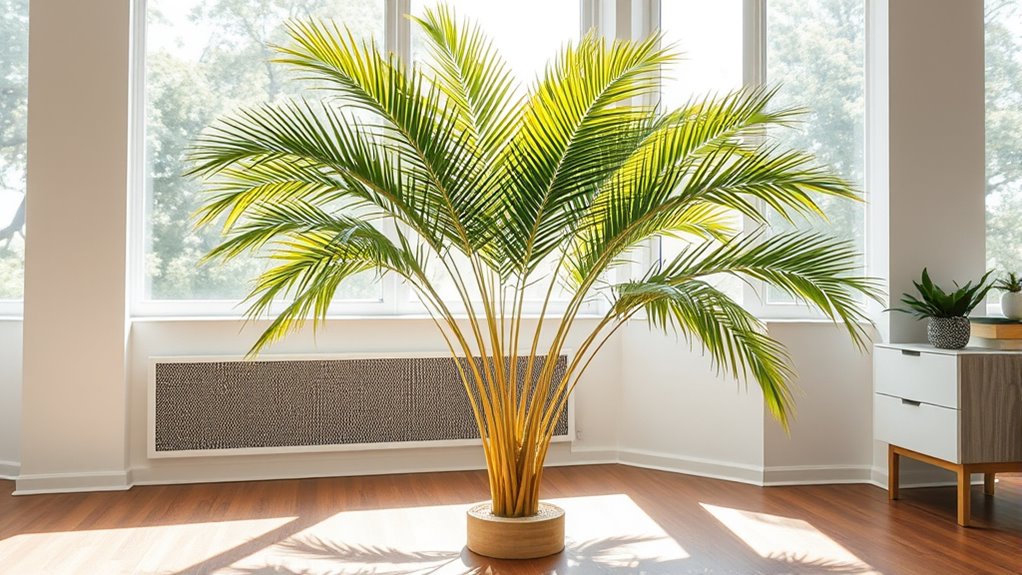
The Areca Palm is an excellent choice for improving indoor air quality with its natural purification abilities. It’s easy to care for, requiring only moderate watering and indirect light, making it suitable for most homes. Plus, its graceful, feathery fronds add a lush, stylish touch to your decor. Incorporating personal growth through caring for houseplants can also boost your well-being and create a more inviting environment.
Air Purification Abilities
Because the Areca Palm (Dypsis lutescens) effectively filters indoor air, it’s a valuable addition to any home or office environment. This plant excels at improving air quality by actively removing airborne pollutants like formaldehyde, xylene, and toluene. Its natural ability to absorb and break down these toxins helps create a healthier indoor environment. As a result, you’ll notice fresher air and fewer irritants that can affect breathing or cause allergies. The Areca Palm’s dense foliage acts as a natural air filter, enhancing pollutant removal and contributing to a cleaner, more breathable space. Incorporating HEPA filtration technology into your air cleaning strategies can further reduce airborne particles and improve overall air quality. By including this plant, you support better indoor air quality, making your environment safer and more comfortable for everyone.
Easy Care Requirements
Areca Palms are known for their ease of care, making them a great choice even for beginners. You won’t need to follow complicated watering routines—simply water when the top inch of soil feels dry. They thrive with consistent moisture but dislike overwatering, so guarantee proper drainage. Regarding light preferences, Areca Palms prefer bright, indirect sunlight. Place them near a window with filtered light to keep their lush fronds vibrant. They can tolerate some lower light, but growth may slow. Regularly misting their leaves helps boost humidity, which these palms appreciate. Overall, they’re forgiving plants that respond well to straightforward care. With minimal effort, you’ll enjoy their tropical elegance and air-purifying benefits in your home. Incorporating natural materials and rustic decor can enhance their ambiance, creating a cozy farmhouse atmosphere.
Aesthetic Indoor Decor
With its graceful, feathery fronds, the Areca Palm (Dypsis Lutescens) instantly elevates indoor decor by adding a tropical touch. Whether placed in a corner or as a focal point, it enhances your indoor garden with its lush, vibrant foliage. Use decorative containers to complement your interior style—rattan baskets for a natural look or sleek ceramic pots for modern elegance. The palm’s airy structure creates visual interest without overwhelming your space. Its height and texture bring dimension, making it ideal for living rooms, offices, or entryways. This plant not only beautifies your environment but also contributes to a calming atmosphere. Incorporating an indoor air purifying plant like the Areca Palm can significantly improve your indoor air quality and overall well-being.
Peace Lily (Spathiphyllum Spp.)
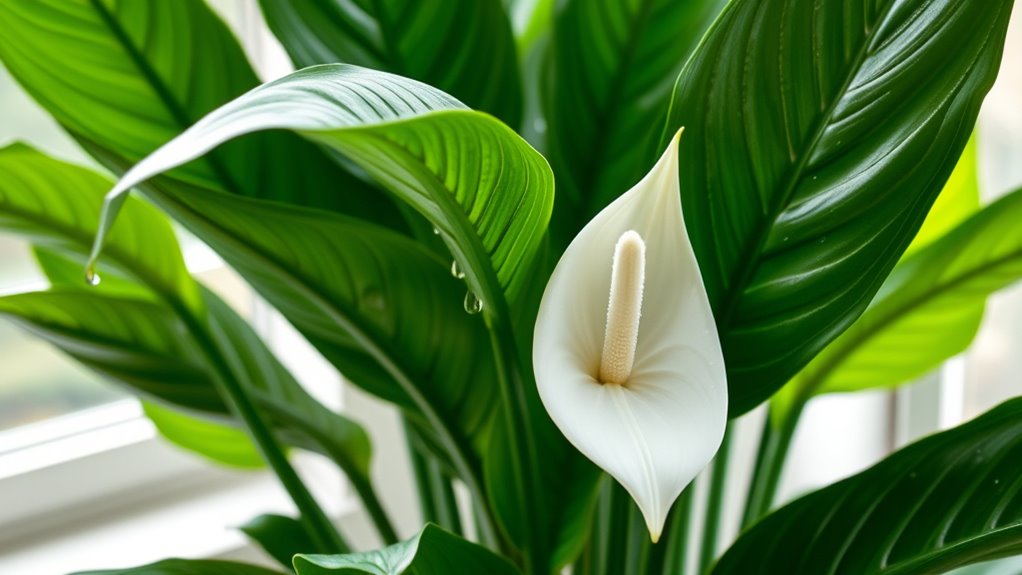
The Peace Lily (Spathiphyllum spp.) is a popular houseplant known for its striking white flowers and lush green leaves. To keep it healthy, you need to monitor soil moisture; it prefers consistently moist but not waterlogged soil. If the soil dries out too much, the plant’s flowering potential diminishes, and leaves may droop. Regular watering ensures the plant remains vibrant and encourages blooming. The Peace Lily’s ability to purify indoor air is enhanced when you maintain proper soil moisture, supporting its overall health. Additionally, providing adequate indirect light boosts its flowering potential, making your space not only more beautiful but also cleaner. Proper air purifier maintenance can help reduce airborne pollutants that might affect the plant’s health. With proper care, this plant will thrive indoors and continue to improve your air quality.
Boston Fern (Nephrolepis Exaltata)
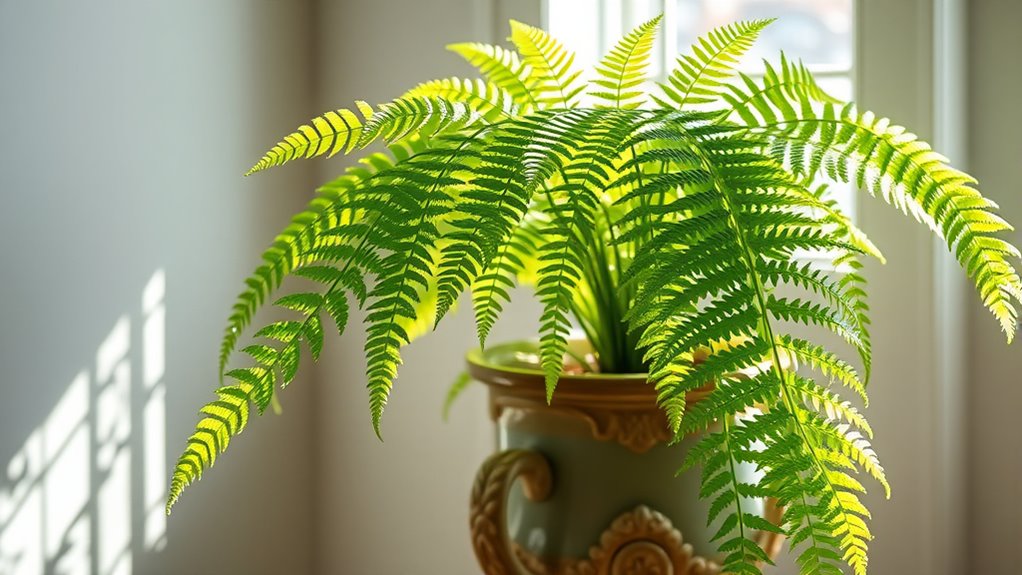
Have you considered adding a Boston Fern (Nephrolepis exaltata) to your indoor space? This lush plant is excellent for humidity regulation, helping keep your home’s air moist and comfortable. Plus, it’s known for strong pest resistance, so you won’t worry about annoying bugs invading your plant.
Here’s why it’s a great choice:
- Naturally boosts indoor humidity levels
- Easy to care for with minimal pest issues
- Adds vibrant greenery and fresh air quality
The Boston Fern thrives in indirect light and prefers consistent moisture, making it perfect for bathrooms or shaded spots. Its ability to regulate humidity and resist pests makes it a practical, beautiful addition to any indoor environment.
Rubber Plant (Ficus Elastica)
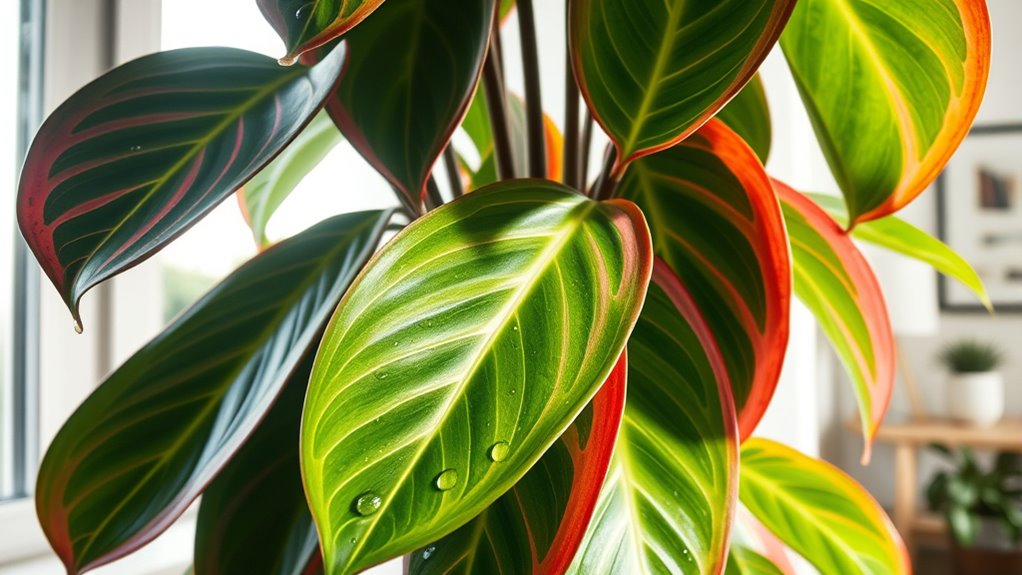
The Rubber Plant (Ficus Elastica) is a powerful air purifier, capable of removing toxins like formaldehyde from your home. It’s also easy to care for, needing only bright, indirect light and occasional watering. With minimal effort, you can enjoy cleaner air and a lush, attractive addition to your space. Additionally, selecting plants with air-purifying capabilities can further enhance indoor air quality.
Air Purifying Capabilities
Rubber plants (Ficus elastica) are effective at removing common indoor pollutants, making them excellent air purifiers. They actively filter toxins like formaldehyde, xylene, and toluene, improving your indoor air quality. As they grow, they help regulate indoor humidity levels, preventing dryness or excess moisture. Plus, their large leaves trap airborne dust, enhancing overall air cleanliness. You can also propagate rubber plants easily, expanding their air purifying benefits throughout your home. Keep in mind, healthy plants contribute more effectively to air purification. Regular pruning and proper plant propagation methods ensure your rubber plant remains vigorous. By incorporating this resilient houseplant, you create a healthier, more comfortable living environment with cleaner, fresher air.
Easy Care Tips
To keep your rubber plant thriving, focus on providing indirect bright light and avoiding direct sunlight, which can scorch its leaves. Maintain consistent watering schedules, allowing the top inch of soil to dry out between waterings to prevent overwatering. During the growing season, typically spring and summer, you might need to water slightly more often, but always check soil moisture first. In fall and winter, reduce watering frequency. Follow a simple fertilization routine by applying a balanced, water-soluble fertilizer every 4-6 weeks during active growth. Avoid over-fertilizing, which can harm the plant. With these easy care tips, your rubber plant will stay healthy, vibrant, and air-purifying. Keep an eye on its needs, and it’ll reward you with lush foliage. Understanding industry trends helps in optimizing your plant care routine for better health and growth.
Chinese Evergreen (Aglaonema Modestum)
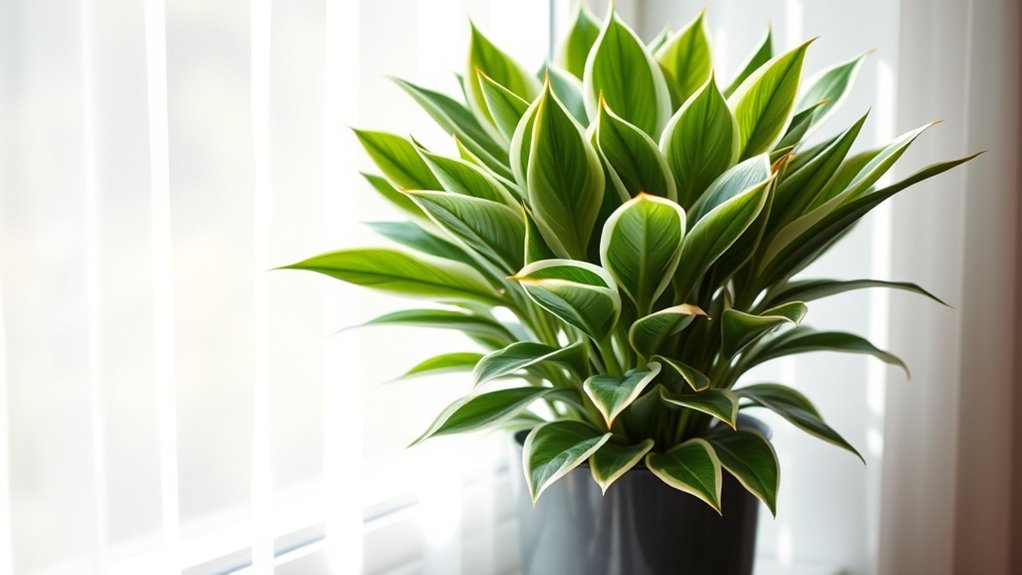
If you’re looking for an easy-care houseplant that improves indoor air quality, the Chinese Evergreen (Aglaonema modestum) is an excellent choice. Known for its resilience, it thrives in low light and requires minimal watering. Its plant growth is steady, making it perfect for busy households. The leaf coloration varies from deep green to silver, adding visual interest to any space. As it matures, you’ll notice the vibrant leaves becoming more pronounced. This plant actively filters airborne toxins, enhancing your indoor environment. To keep it healthy, avoid direct sunlight and overwatering. Regularly wipe its leaves to maximize air purification and maintain vibrant leaf coloration. Overall, Chinese Evergreen combines aesthetic appeal with air-cleaning benefits, making it a smart addition to your home. Understanding chemical reactions involved in air filtration can deepen your appreciation for how plants purify indoor air.
Frequently Asked Questions
How Often Should I Water These Air-Purifying Houseplants?
You should establish a consistent watering schedule based on your plant’s soil moisture. Check the top inch of soil; if it feels dry, it’s time to water. Many air-purifying houseplants prefer their soil to stay slightly moist but not waterlogged. Adjust your watering frequency accordingly—usually once a week or when the soil dries out. Proper watering helps these plants thrive and effectively purify your indoor air.
Can These Plants Tolerate Low-Light Indoor Environments?
You wanna know if these plants can handle low-light conditions? Many of them have high shade adaptability and low light tolerance, making them perfect for dimly lit rooms. They thrive in indirect sunlight or even in spaces with minimal natural light. With proper care, you can enjoy healthy, air-purifying plants indoors, even in areas where sunlight is scarce. Just guarantee you choose varieties known for their low light resilience.
Are These Plants Safe for Pets and Children?
You might find it interesting that many air-purifying houseplants also pose pet and child safety risks. While some plants help improve indoor air quality, others can be toxic if ingested. Always check for pet safety and child safety before bringing new plants inside. It’s important to choose non-toxic options or place plants where curious pets and children can’t reach, ensuring your home stays both healthy and safe.
What Are the Common Pests That Affect These Houseplants?
You should know that common pests like spider mites, aphids, and mealybugs can affect your houseplants. To keep these pests at bay, practice pest prevention by regularly inspecting your plants and removing any visible bugs. Use organic pest control methods such as neem oil or insecticidal soap, which are safe for indoor environments. Staying vigilant helps protect your plants and keeps your air purified effectively.
How Quickly Do These Plants Improve Indoor Air Quality?
Imagine your home as a busy city, where each building’s air quality improvement depends on its residents. Some houseplants, like snake plants and pothos, can start purifying the air within 24 to 48 hours, thanks to their rapid plant growth speed. These plants actively filter toxins, so you’ll notice fresher air quickly. Their fast action makes them perfect for boosting indoor air quality almost immediately.
Conclusion
Just like Pandora’s box, your home can release a world of cleaner air with these plants. By adding a snake plant or peace lily, you’re inviting a breath of fresh air, turning your space into a sanctuary. Think of them as your personal superheroes, quietly battling pollutants while you relax. Embrace these green allies, and watch your indoor air quality transform—because, like a story from the Garden of Eden, a healthier home starts with a simple, verdant touch.
